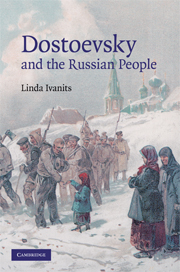Book contents
- Frontmatter
- Contents
- Acknowledgments
- Note on transliteration
- Introduction: the people in Dostoevsky's art and thought
- 1 The face of the people, 1821–1865
- 2 The world of the people in Crime and Punishment
- 3 The Idiot: where have all the people gone?
- 4 Fumbling toward Holy Russia in The Devils
- 5 Back in Russia: the face of the people, 1871–1877
- 6 The Brothers Karamazov: Christ walks the Russian land
- Concluding remarks: Dostoevsky and the people
- Notes
- Bibliography
- Index
6 - The Brothers Karamazov: Christ walks the Russian land
Published online by Cambridge University Press: 22 September 2009
- Frontmatter
- Contents
- Acknowledgments
- Note on transliteration
- Introduction: the people in Dostoevsky's art and thought
- 1 The face of the people, 1821–1865
- 2 The world of the people in Crime and Punishment
- 3 The Idiot: where have all the people gone?
- 4 Fumbling toward Holy Russia in The Devils
- 5 Back in Russia: the face of the people, 1871–1877
- 6 The Brothers Karamazov: Christ walks the Russian land
- Concluding remarks: Dostoevsky and the people
- Notes
- Bibliography
- Index
Summary
Dostoevsky interrupted The Diary of a Writer from 1878 until late 1880 to write The Brothers Karamazov, which proved to be his final and greatest masterpiece. The plot centers on the murder of the dissolute landowner Fedor Pavlovich Karamazov and the false conviction of his eldest son Dmitry. The action occurs in the provincial town of Skotoprigonevsk (Cattle Pen) during several days in August and November in the mid 1860s. Despite the narrator-chronicler's claim that Alesha, the youngest son of Fedor Pavlovich, is the true, albeit, future hero of his tale, the story focuses mainly on the two older brothers, Dmitry and Ivan. This trebling of protagonists renders the structure of The Brothers Karamazov more complex than that of the previous novels and facilitates the inclusion of subplots, inserted narratives, and a wide range of secondary characters, including many from the narod.
At the heart of the plot lies a sensational parricide that captures the attention of all Russia. But, as the narrator reminds us at the outset, the death of Fedor Pavlovich forms only the “external side” of the story (14: 12). Beneath the drama of the Karamazovs lie questions about the existence of God and the nature of human beings that haunted Dostoevsky throughout his life. Burdened by his worsening emphysema and persistent epilepsy, the writer sensed he did not have long to live and seemed to regard this work as a possible final testament.
- Type
- Chapter
- Information
- Dostoevsky and the Russian People , pp. 159 - 188Publisher: Cambridge University PressPrint publication year: 2008



